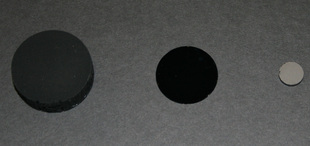Jan 24 2008
Researchers at Rensselaer Polytechnic Institute and Rice University have created the darkest material ever made by man.

The material, a thin coating comprised of low-density arrays of loosely vertically-aligned carbon nanotubes, absorbs more than 99.9 percent of light and one day could be used to boost the effectiveness and efficiency of solar energy conversion, infrared sensors, and other devices. The researchers who developed the material have applied for a Guinness World Record for their efforts.
“It is a fascinating technology, and this discovery will allow us to increase the absorption efficiency of light as well as the overall radiation-to-electricity efficiency of solar energy conservation,” said Shawn-Yu Lin, professor of physics at Rensselaer and a member of the university’s Future Chips Constellation, who led the research project. “The key to this discovery was finding how to create a long, extremely porous vertically-aligned carbon nanotube array with certain surface randomness, therefore minimizing reflection and maximizing absorption simultaneously.”
The research results were published in the journal Nano Letters.
All materials, from paper to water, air, or plastic, reflect some amount of light. Scientists have long envisioned an ideal black material that absorbs all the colors of light while reflecting no light. So far they have been unsuccessful in engineering a material with a total reflectance of zero.
The total reflectance of conventional black paint, for example, is between 5 and 10 percent. The darkest manmade material, prior to the discovery by Lin’s group, boasted a total reflectance of 0.16 percent to 0.18 percent.
Lin’s team created a coating of low-density, vertically aligned carbon nanotube arrays that are engineered to have an extremely low index of refraction and the appropriate surface randomness, further reducing its reflectivity. The end result was a material with a total reflective index of 0.045 percent – more than three times darker than the previous record, which used a film deposition of nickel-phosphorous alloy.
“The loosely-packed forest of carbon nanotubes, which is full of nanoscale gaps and holes to collect and trap light, is what gives this material its unique properties,” Lin said. “Such a nanotube array not only reflects light weakly, but also absorbs light strongly. These combined features make it an ideal candidate for one day realizing a super black object.”
“The low-density aligned nanotube sample makes an ideal candidate for creating such a super dark material because it allows one to engineer the optical properties by controlling the dimensions and periodicities of the nanotubes,” said Pulickel Ajayan, the Anderson Professor of Engineering at Rice University in Houston, who worked on the project when he was a member of the Rensselaer faculty.
The research team tested the array over a broad range of visible wavelengths of light, and showed that the nanotube array’s total reflectance remains constant.
“It’s also interesting to note that the reflectance of our nanotube array is two orders of magnitude lower than that of the glassy carbon, which is remarkable because both samples are made up of the same element – carbon,” said Lin.
This discovery could lead to applications in areas such as solar energy conversion, thermalphotovoltaic electricity generation, infrared detection, and astronomical observation.
Other researchers contributing to this project and listed authors of the paper include Rensselaer physics graduate student Zu-Po Yang; Rice postdoctoral research associate Lijie Ci; and Rensselaer senior research scientist James Bur.
The project was funded by the U.S. Department of Energy’s Office of Basic Energy Sciences and the Focus Center New York for Interconnects.
Lin’s research was conducted as part of the Future Chips Constellation at Rensselaer, which focuses on innovations in materials and devices, in solid state and smart lighting, and applications such as sensing, communications, and biotechnology. A new concept in academia, Rensselaer constellations are led by outstanding faculty in fields of strategic importance. Each constellation is focused on a specific research area and comprises a multidisciplinary mix of senior and junior faculty, as well as postdoctoral researchers and graduate students.